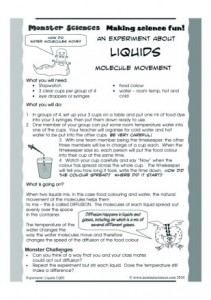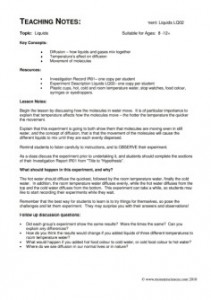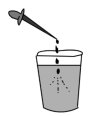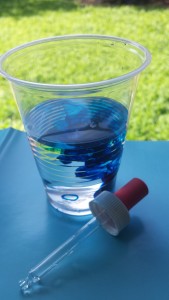What do water molecules look like and how do they behave? Find out in this fun liquids science experiment.
 |
 |
What you will need:
- Stopwatch
- 3 clear cups per group of 4
- eye droppers or syringes
- food colour
- water – room temp, hot and cold
What you will do:
- In groups of 4, set up your 3 cups on a table and put one ml of food dye into your 3 syringes, then put them down ready to use.
- One member of your group can put some room temperature water into one of the cups. Your teacher will organise for cold water and hot water to be put into the other cups. Be very careful!
- With one team member being the timekeeper, the other three members will be in charge of a cup each. When the timekeeper says so, each person will put the food colour into their cup at the same time.
- Watch your cup carefully and say “Now” when the colour has spread across the whole cup. The timekeeper will tell you how long it took, write the time down, How did the colour spread? Where did it start?
What is going on?
When two liquids mix, in this case food colouring and water, the natural movement of the molecules helps them
to mix – this is called DIFFUSION. The molecules of each liquid spread out evenly over the space
in the container.
The temperature of the water changes the
way the water molecules move and therefore changes the speed of the diffusion of the food colour.
Monster Challenges:
- Can you think of a way that you and your class mates could act out diffusion?
- Repeat the experiment but stir each liquid. Does the temperature still make a difference?
Teaching Notes: Monster Science Experiment: Liquids LQ02
Topic:
Liquids
Key Concepts:
- Diffusion – how liquids and gases mix together
- Temperature’s affect on diffusion
- Movement of molecules
Resources:
- Investigation Record IR01– one copy per student
- Experiment Description Liquids LQ02– one copy per student
- Plastic cups, hot, cold and room temperature water, stop watches, food colour, syringes or eyedroppers.
Lesson Notes:
Begin the lesson by discussing how the molecules in water move. It is of particular importance to explain that temperature affects how the molecules move – the hotter the temperature the quicker the movement.
Explain that this experiment is going to both show them that molecules are moving even in still water, and the concept of diffusion, that is that the movement of the molecules will cause the different liquids to mix until they are each evenly dispersed.
Remind students to listen carefully to instructions, and to OBSERVE their experiment.
As a class discuss the experiment prior to undertaking it, and students should complete the sections of their Investigation Report IR01 from ”Title to “Hypothesis”.
What should happen in this experiment, and why?
The hot water should diffuse the quickest, followed by the room temperature water, finally the cold water. In addition, the room temperature water diffuses evenly, while the hot water diffuses from the top and the cold water diffuses from the bottom. This experiment can take a while, so students may like to start recording their experiments while they wait.
Remember that the best way for students to learn is to try things for themselves, so pose the challenges and let them experiment. They may surprise you with their answers and observations!
Follow up discussion questions:
Did each group’s experiment show the same results? Were the times the same? Can you explain any differences?
- How do you think the results would change if you added liquids of three different temperatures to room temperature water?
- What would happen if you added hot food colour to cold water, or cold food colour to hot water?
- Where do we see diffusion in our normal lives or in nature?




